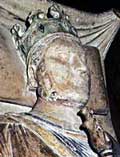 |
Henry II
b. 4/5 Mar 1133, Le Mans, Maine
d. 6 Jul 1189, Chinon Castle, Anjou |
| Title: |
Dei Gracia Rex Anglorum et Dux Normannorum et Aquitanorum et comes Andegavorum (By the Grace of God, King of the English and Duke of the Normans and Aquitanians and Count of the Angevins) [1] |
| Term: |
19 Dec 1154 - 6 Jul 1189 |
| Chronology: |
19 Dec 1154, crowned, Westminster Abbey (Hoveden, 1:213) |
| |
6 Jul 1189, died (Hoveden, 2:367) |
| Names/titles: |
Dux Normannorum (duke of the Normans) [from 1149/1150]; count of Anjou and Maine and Touraine [from 7 Sep 1151]; dux Aquitanorum (Duke of Aquitaine) (from 18 May 1152); byname: Henry FitzEmpress |
| Biography: |
| Henry was the son of Geoffroi "Plantagenêt", count of Anjou, and Empress Matilda, who was the daughter of King Henry I. Henry was invested with the duchy of Normandy by his father in 1149/1150, and when the latter died (1151) the 18-year-old Henry also became the count of Anjou and Maine and Touraine. In 1152 Henry married Eleanor (Aliénor), duchess of Aquitaine, almost immediately after the annulment of her marriage to Louis VII of France. In 1153 Henry took up the claim of his mother to the throne of England occupied by Stephen of Blois since 1135. An expedition to England undertaken by Henry in 1153 resulted in signing the treaty of Winchester (6 Nov 1153). Stephen retained the kingship for his lifetime and Henry was acknowledged as heir to Stephen by a charter issued at Westminster on 25 Dec 1153. Stephen died on 25 Oct 1154 and Henry reached England, after storm delays, on 7 Dec 1154. He was crowned on 19 Dec 1154. The early years of Henry's reign witnessed the struggle with powerful English barons, who gained lands and castles during the anarchy of Stephen's time. After he settled the claims of his brother, Geoffrey, to Anjou and Maine, Henry recovered the northern counties from Scotland. In 1158-1163 Henry worked on strengthening and expanding the Angevin continental possessions2, but major expedition to Toulouse proved to be a failure. The consolidation of royal authority in England under Henry II led to legal reforms. The Constitutions of Clarendon, approved by a great council in early 1164, changed the practices of ecclesiastical courts separated from the temporal by the edict of William I. Defending the old tradition, Henry's close friend and chancellor since 1155, Thomas à Becket, archbishop of Canterbury, opposed the royal justice. The long conflict between the king and the archbishop came to an end when Becket was murdered at Canterbury (29 Dec 1170) by four of Henry's knights. In October 1171 Henry II landed in Ireland to conquer the island and was accepted as overlord by the Irish kings. In 1173 Henry's eldest son, Henry the "Young King", launched a rebellion against his father followed by a series of wars between the old king and his sons. The deaths of the "Young King" (1183) and his brother, Geoffrey (1186), gave no respite to Henry. In 1189 his third son, Richard (later King Richard I), with the assistance of Philippe II of France, attacked and defeated Henry, forcing him to accept a humiliating peace at Colombières (4 Jul 1189). Worn out and ill, the king died two days later (6 Jul 1189). [3; 4; 5] |
|
|
| |
| [1] |
Before his coronation at Westminster, Henry used the style "dux Normannorum et Aquitanorum et comes Andegavorum". The words "dei gracia" ("By the Grace of God") appearing on the Great Seal since the time of William II, were not, as a rule, added to the style of the king in charters and writs until May 1172, when Henry II commenced a practice which has since been consistently followed. |
| [2] |
Absences: 10 Jan 1156 - Apr 1157; 14 Aug 1158 - 25 Jan 1163; Mar 1166 - 3 Mar 1170; Jun 1170 - Sep 1171; Oct 1171 - Apr 1172; May 1172 - 8 Jul 1174; 8 Aug 1174 - 9 May 1175; 18 Aug 1177 - 15 Jul 1178; Apr 1180 - 26 Jul 1181; 4 Mar 1182 - 10 Jun 1184 (1183?); 16 Apr 1185 - 27 Apr 1186; 17 Feb 1187 - 30 Jan 1188; 10 Jul 1188 - 6 Jul 1189. |
| [3] |
Handbook of British Chronology (1986) |
| [4] |
"Henry II", by W.L. Warren (University of California Press, Berkeley 1973). |
| [5] |
"Henry II, Duke of Normandy and Aquitaine", by Z.N. Brooke and C.N.L. Brooke, ENGLISH HISTORICAL REVIEW 61 (1946), pp. 81-89. |
| |
Image: tomb effigy of King Henry II, Fontevrault Abbey, Anjou. |

